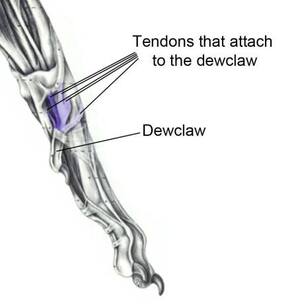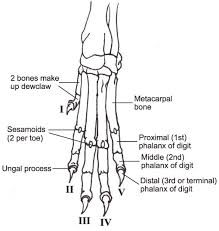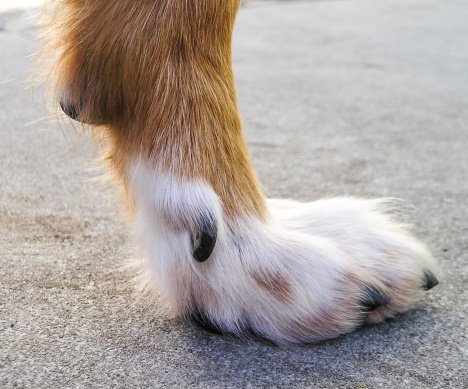|
Dewclaw removal is a common practice for many North American dog breeders and owners but questions are raised over the appropriateness of removal. Amongst our European counterparts' removal of dewclaws is a rare occurrence. So what is the dewclaw and why is removing it something we should reconsider? What is the dewclaw?All dogs are born with a toenail on the inside of their front legs called the dewclaw. When looking at a dog's foot the toes that make contact with the ground are essentially the pinky, ring, middle, and index fingers - the dewclaws are like the thumb. Feeling the nail you should be able to move the dewclaw a little (forwards and backwards) and you'll probably be able to feel the tendons that connect the nail to the leg. The presence of these tendons suggests that the front dewclaw has a function and that removal of the front dewclaw may have lifelong consequences for our dogs. There are some breeds (Great Pyrenees, Saint Bernard, and Briards) that are born with dewclaws on all four legs or even double dewclaws on the rear leg. Some believe that the presence of rear dewclaws on the Great Pyrenees was purposely bred to give greater stability when working on rough terrain and snow. However, in most breeds the presence of a rear dewclaw is rare and are often non-functional meaning that there is no tendon attaching. When feeling the rear dewclaws you'll be able to move the nail more freely as they're often only attached by skin. When standing, the front dewclaw may not appear to be functional because it doesn't come in contact with the ground but observing the dewclaw when the dog is in motion tells a different story. The function of front dewclaws Five tendons attach to the dewclaw and play an important role when the dog is in motion. For example:
The Research Behind Digit Injuries A 2018 study of digit injuries found that digit injuries were more likely to occur in the front limbs (P< 0.001) than hind and that digit 5 (the outside digit) was the most frequently injured while the dewclaw (digit 1) was the least frequently injured. Previous research has thought that our dog’s third and fourth digit were the most important due to their central location within the feet and due to their length in comparison to other toes but research has shown that substantial weight is also placed on the fifth pad and on the metacarpophalangeal and metatarsophalangeal pads. This observation was also found within the present study with digit 5 seeing the most amount of injury. The researchers suggested that forces applied when dogs are turning at high speeds on the agility course may act as repetitive stressors to digits 3, 4, and 5 and that these digits may be of more importance to athletic function than previously recognized. Of particular note is the research found that the first digit (the dewclaw) was at a low risk of injury. The results of the study suggested that the removal of the dewclaws in the forelimb may be a risk factor for injury to other digits. The front dewclaws may have a function in preventing torque on the limb, and as such, the removal of dewclaws may predispose the dog to injury. Source: Cullen KL, Dickey JP, Bent LR, Thomason JJ, MoÃns NM. Survey-based analysis of risk factors for injury among dogs participating in agility training and competition events. J Am Vet Med Assoc. 2013;243:1019-24. Why do some advocate front dewclaw removal?There are a number of reasons why someone may choose to remove front dewclaws from their dog. Breeders may choose to remove dewclaws on 3-5 day old puppies or owners may choose to remove front dewclaws later in life. This choice can be very personal and can vary between owners, breeders, veterinarians and dog breeds. So what are some of the reason behind removal?
How to Avoid Injury to the DewclawKeeping the nail short is key to avoiding injury with dewclaws! Like other toenails the nail of dewclaw needs to be trimmed regularly but due to the location of the dewclaw the nail will not make contact with the ground and will not wear down naturally like other toenails. Left untrimmed the nail can curve down and become ingrown, risking infection. Untrimmed, the nail will also develop a longer quick making it difficult to maintain proper length. Long dewclaws also have a greater risk of catching on things and risk injury. Speaking with vets, you may be surprised at how few dewclaw injuries they see in dogs with well managed nails. Another important factor in reducing injury to this nail is to educate owners! If removal of the dewclaw is done because of a fear that new owners will fail to properly maintain them then I would argue that breeders need to do more to educate their puppy owners about the location and care of dewclaws. While I would prefer not to remove dewclaws from dogs all three of my own dogs have had them removed by their breeders. So, knowing what we do about the function of dewclaws in reducing force how can I help my dogs minimize the extra force they experience on their shoulder complex? Thankfully, there are a number of conditioning exercises we can do to help dogs with missing front dewclaws. Exercises that strengthen the scapular muscles of the shoulder such as side-stepping, tight turns with cookies, and weight shifting work can all help to reduce the risk of to the forelimb and shoulder. If you would like to see more about the function of dewclaws and see dewclaws in action make sure to check out the videos below! If you would like to learn more about how to help your dog compensate for their dewclaw removal please don't hesitate to contact me for help!
16 Comments
Christine
1/3/2020 12:22:33 pm
Good read. I’ve seen firsthand how my KaBam my pit use his dew claws in agility to prevent sliding off the table and to keep his balance on the dog walk.
Reply
Jeannine
12/5/2021 05:20:50 pm
Both my BCs have dew claws to help with agility
Reply
Elise Collins
10/19/2020 03:48:02 pm
Really interesting. I see how important these few claws are, especially in cold weather , in and around ponds. So glad I watched.
Reply
Dennis Edersheim
12/10/2020 05:15:25 pm
Our American Chocolate Lab has a long one. My wife asked me to look into dewclaws.
Reply
Carolyn McIntyre
12/11/2020 07:40:43 am
Glad we could help!
Reply
Carolyn Butterworth
1/7/2021 05:52:43 am
My young staffie cross is continually gnawing his dew claw ?
Reply
Denise Thomson
1/28/2021 06:59:12 pm
My Girls dewclaw is sensitive it's white and I can see the red ,she won't let it be trimmed ,is that red a vein ?
Reply
Carolyn McIntyre
3/1/2021 01:25:38 pm
Hi Denise,
Reply
2/18/2021 07:57:08 am
Amazing article!! I had never seen the ice pictures and that was stunning. Thank you so much for a brilliant article. I love that you talk about the strategies for dogs who don't have dewclaws.
Reply
Ellie
8/3/2021 11:58:56 am
Is it possible that one or more tendons of the dew claw are injured? My beauceron (13 months old) has one which pointed almost horizontal since a short time and she sometimes limps. The dew claw is much more moveable than the other which I don't do because it seams not feeling well..
Reply
Jane Tutton
10/27/2021 04:15:36 pm
I have seen a lot about this and my dog before my latest puppy did not have dew claws. She would have used them, I saw that. I met a breeder who agreed, she's a vet, and my current puppy has her dew claws. I really think it helps her. I trained her to the dremel and I dremel the front 2x a week and back 1x a week, so they are not a problem.
Reply
2/8/2022 03:01:42 pm
I am interested in reprinting this article for $100.
Reply
Michelle Mullens
1/24/2023 08:39:21 am
Thank you for this informative article highlighting the importance of a digit that seemingly only vainglorious and thoughtless North American breeders amputate to seek an arbitrary "look" in a show ring for a few seasons or to follow along mindlessly with unquestioned harmful precedent.
Reply
Spencer
3/20/2023 04:29:48 pm
Glad you included a bit on injury prevention if a dog already has theirs removed. My breeder had my lab’s removed and he does a lot of hiking, and running so I’m a bit worried about the effect of missing the dew claws!
Reply
Leave a Reply. |
AuthorCarolyn McIntyre Archives
March 2024
Categories
All
|


 RSS Feed
RSS Feed